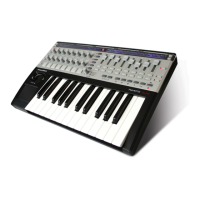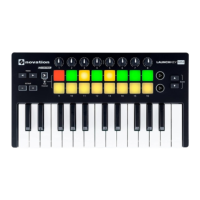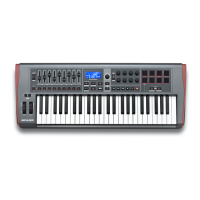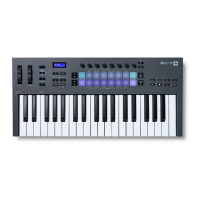37
RE4: Input 2 level
Displayed as: Input2
Default value: 0
Range of adjustment: 0 to 127
Audio from Input 2 may be mixed into Outputs 3 and 4 by adjusting RE4. With Input Link-
ing (RE1 on Audio Menu Page 1) set to Indept, RE4 adjusts level for Input 2 only. With
Input Linking set to Stereo, the level of both Inputs 1 and 2 will be adjusted as a pair.
RE5: Outputs 3 & 4 Level
Displayed as: Level
Default value: 127
Range of adjustment: 0 to 127
This is an independent level control which adjusts the output volume at Outputs 3 and 4 at
all times. (This is the equivalent of Outputs 1/2’s MASTER VOLUME hardware control.)
RE6: Outputs 3 & 4 Balance
Displayed as: Balance(Host3+4/Synth+Inps)
Default value: 0
Range of adjustment: -64 to +63
The mix available at Outputs 3 and 4 may also include audio from DAW Channels 3+4, and
this control provides a balance between this audio and the mix of synth sound and audio
inputs set up with RE3, RE4 and RE5. With a value of -64, only the DAW channels will be
heard; with a value of +63, only the synth/inputs mix will be heard. A setting of zero gives
an equal blend.
RE8: Not used.
If you want to use the Ultranova’s FX engine to process audio from the DAW
(e.g., a rhythm track) use two jack cables to connect Outputs 3 & 4 to Inputs 1 &
2. You can now add effects processing to the rhythm track in the same way you
can add effects to any other input.
Audio Menu Page 5 – SPDIF Output
RE1: SPDIF Output
Displayed as: SPDIF
Default value: Off
Range of adjustment: On, Off
The SPDIF output can be turned On or Off.
global SettIngS
Pressing the GLOBAL button [31] opens the Global Menu (seven pages). This menu
contains a set of synth and audio system functions which, once set up, will not generally
need to be accessed on a regular basis. The Global Menu also includes the routines to
update the UltraNova’s Operating System. Note that settings made in the Global Menu are
not saved with any Patch changes. However, it is possible to save the Global Menu settings
(along with the Audio Menu settings at the same time) by pressing WRITE [23] while in the
Global (or Audio) menu. This will ensure that the next time you power up your UltraNova,
these settings will be restored instead of the original factory defaults.
Global Menu Page 1 – MIDI and other settings
RE1: Memory Protection
Displayed as: Protect
Default value: Off
Range of adjustment: Off or On
This is a safety feature, used to prevent accidental erasure of memories and loss of data.
When set to On, writing Patches or Global data into memory will be prevented, and a brief
warning message (CANNOT SAVE – MEMORY PROTECT IS ON !!) shown on the
UltraNova’s display. It is recommended that Memory Protect is left On unless Patches are
being edited for storing in memory, or a System Exclusive dump from a computer is to be
received.
RE2: Local Control On/Off
Displayed as: Local
Default value: On
Range of adjustment: Off or On
This control determines whether the UltraNova is to be played from its own keyboard, or
to respond to MIDI control from an external device, such as a MIDI sequencer or master
keyboard. Set Local to On to use the keyboard, and to Off if you are going to control the
synth externally via MIDI or use the UltraNova’s keyboard as a master keyboard.
A primary use of Local Control On/Off is to avoid unwanted MIDI loops through
external equipment. When set to Off, the UltraNova’s keyboard and all other
controls still transmit MIDI messages from the MIDI OUT port if MIDI OUT On/
Off (RE4) is enabled. If any external equipment is set to re-transmit MIDI back to the
UltraNova, then the synth will still operate. This will avoid notes sounding twice, a reduction
in polyphony or any other unpredictable effects.
RE3: Assign MIDI Channel
Displayed as: MidiChan
Default value: 1
Range of adjustment: 1 to 16
The MIDI protocol provides 16 channels allowing up to 16 devices to co-exist on a MIDI
network, if each is assigned to operate on a different MIDI channel. Assign MIDI Channel
lets you set the UltraNova to receive and transmit MIDI data on a particular channel, so that
it can interface correctly with external equipment.
RE4: MIDI Out On/Off
Displayed as: MidiOut
Default value: Off
Range of adjustment: Off or On
This control enables the UltraNova to transmit MIDI Out messages from the MIDI OUT
port [4] as the synth is played. Set this parameter to On if you want to record MIDI data
or trigger additional external MIDI equipment from the UltraNova’s keyboard via the MIDI
OUT port. However, it is important to note that MIDI data is always transmitted via USB.
RE5: Touched/Filter knob control
Displayed as: Touch/Filter
Default value: Set by Patch
Range of adjustment: Set by Patch or Always Filter
This setting determines how the TOUCHED/FILTER knob [9] operates. With the default
setting of Set by Patch, the knob operates as described on page 27, either acting as a
copy of the last rotary control to be touched or, with FILTER [8] enabled, to vary the cut-off
frequency of Filter 1. Because the setting of the FILTER button is saved with the Patch
data, the function of the knob is determined by the Patch. If RE5 is set to Always Filter,
the TOUCHED/FILTER knob is set to control the filter frequency permanently.
RE6 to RE8: Not used.
Global Menu Page 2
– Tuning, Velocity, sampling frequency and footswitch
RE1: Master Fine Tuning
Displayed as: TuneCent
Default value: 0
Range of adjustment: -50 to +50
This control adjusts the frequencies of all the Oscillators by the same small amount,
allowing you to fine-tune the whole synth to another instrument if necessary.
The increments are cents (1/100 of a semitone), and thus setting the value to 50 tunes
the synth to a quarter-tone midway between two semitones. A setting of zero tunes
keyboard with the A above middle C at 440 Hz – i.e., standard Concert Pitch.
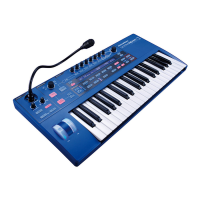
